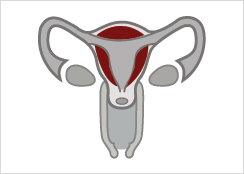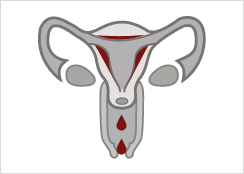Q. How does menstruation work?
A. Women experience menstruation for an average of 35 to 40 years of their lives. Since each menstrual period lasts for about five days a month, most women have to deal with it for more than six and a half years over their lifetimes. Menstruation is an important process in women's bodies.
There are 4 phases in the menstrual process:

1. The proliferative phase (follicular phase)

During this phase, a primary follicle begins to grow in the ovary, induced by a follicle-stimulating hormone secreted from the pituitary gland. As the follicle matures and the estrogen hormone is secreted, the uterine lining starts to gradually thicken.
2. Ovulation

The ovum bursts out of its follicle when the levels of the follicle-stimulating hormone (FSH) and the luteinizing hormone (LH) reach their peaks, stimulating the matured follicle. This is referred to as ovulation. Some women experience lower abdominal pain at this time.
3. The secretory phase (luteal phase)

Following ovulation, the progesterone hormone induces the uterine lining to further thicken and form a cushion preparing the uterine lining for a fertilized egg to be implanted in it.
4. The menstrual phase

During the menstrual phase, pregnancy occurs when an ovulated egg is fertilized by a sperm and implants itself into the lining of the uterus. If pregnancy doesn't occur, the estrogen and progesterone levels drop and the uterus will shed its unused lining and expel it along with blood. This process is referred to as menstruation.
Q. Does the presence of Staphylococcus aureus always lead to TSS?
A. The inner wall of the uterus is lined with a substance called the endometrium. This uterine lining gradually thickens in response to the menstrual cycle and becomes approximately one centimeter thick before menstruation begins.
You might picture it as a kind of solid wall, but the endometrium is actually a layer of tissue consisting of cells, capillaries, and glands that produce secretions.
When menstruation begins, the functional surface layer of the endometrium breaks down and peels off. This is what causes bleeding during a period. You may experience blood expelling in lumps during the heaviest flows of your menstruation. This is because your body is unable to create enough enzyme to keep the blood from clotting, resulting in period cramps.
Q. How long should a period last?
A. A regular menstrual period lasts from 3 to 7 days.
Q. Why does my period last for several days?
A. It takes a few days to expel menstrual fluid, not only due to the size of the uterus or the level of hormonal secretions that month, but also due to the size of the opening for fluid flow into the vagina. The entrance to the uterus is very small, narrower than the hole of a drinking straw. This means it takes a few days for the blood to pass through it.
During menstruation, the uterus contracts to expel the blood inside, like squeezing paint out of a tube. The position of the uterus also has an influence on how blood is expelled. In its normal position, the angle of the uterus allows blood to flow out smoothly. However, the discharge of blood is hindered if the uterus is tilted too far forwards or backwards, causing the bleeding to be prolonged or to seemingly pause and then increase later in menstruation.
Q. How long is a menstruation cycle?
A. An average menstrual cycle is 28 days but this number varies from woman to woman. A cycle is considered normal if it lasts anywhere between 21 to 35 days. Your cycle is calculated from Day 1 of your periods and ends just before your next period starts.
Q. What is in menstrual blood?
A. Menstrual blood consists of the shed layer of the uterine lining (broken down and expelled) as well as tissue particles and hormone secretions.
Q. Why do I experience irritability and discomfort before my period begins?
A. Many women experience both physical and emotional anxiety during the premenstrual period due to significant changes in hormone levels. These symptoms are attributed to PMS (Premenstrual Syndrome). Find out more about PMS here
Q. Why are period cramps painful?
A. The pain of period cramps is caused by the contraction of the uterus as it tries to push menstrual blood out. It can also be due to pelvic congestions due to hormone imbalances, bad blood circulation and stress. Read tips about how you can deal with period cramps here
Q. Why are my periods irregular?
A. There are several reasons that could be causing this. First, you may have a hormonal imbalance. Stress is also another contributing factor to irregular periods. Intense dieting or exercising may also be causes of irregular periods. If this problem persists, we advise you to seek the help of a gynaecologist.
Q. Is it normal to have vaginal discharge?
A. Yes, it's perfectly normal – all women have vaginal discharge! Vaginal discharge is a combination of cervical mucus and vaginal secretions. It has an important protective function by keeping the vagina lubricated and preventing bacteria and other germs from entering the uterus. This is a part of the self-cleansing mechanism of the vagina.
Q. How do I know if my vaginal discharge is normal?
A. Normal vaginal discharge is usually clear, white-ish or slightly yellowish in colour. It should have a subtle smell, or no smell at all. It should not itch or cause discomfort when urinating or during intercourse. Should your vaginal discharge be grey or green in colour, have a foul smell, or cause you pain and itchiness, please seek the help of a gynaecologist immediately.
Q. Why do I sometimes get rashes and itchiness during menstruation?
A. More than a few women seem to be troubled by rashes and itchiness during menstruation, but the number seems to be falling as the quality of sanitary products has improved. The major causes of rashes and itching during menstruation are dampness and chafing. Being in contact with sanitary pads can result in the vagina being kept damp. You are bound to get rashes under such a condition as the remaining menstrual flow and any sweat that has not been absorbed by the sanitary pad irritate the skin. Chafing is another cause. When the skin is dry, for example, the area can be chafed when the skin rubs against the sanitary pad while you are moving or walking.
Q. How can I prevent rashes and itching during menstruation?
A. Choose the right sanitary pad that offers comfort – try one from our range of products here.
You should also change pads frequently (once every 3 – 4 hours) and ensure personal hygiene during menstruation. Be mindful to get sufficient sleep to boost your immunity as you are more prone to rashes when your body's defenses are down.
If you find that the rashes and itching persists despite taking preventive measures, you might have sensitive skin or allergies. Please seek the advice of a gynaecologist or dermatologist to identify a suitable treatment.








